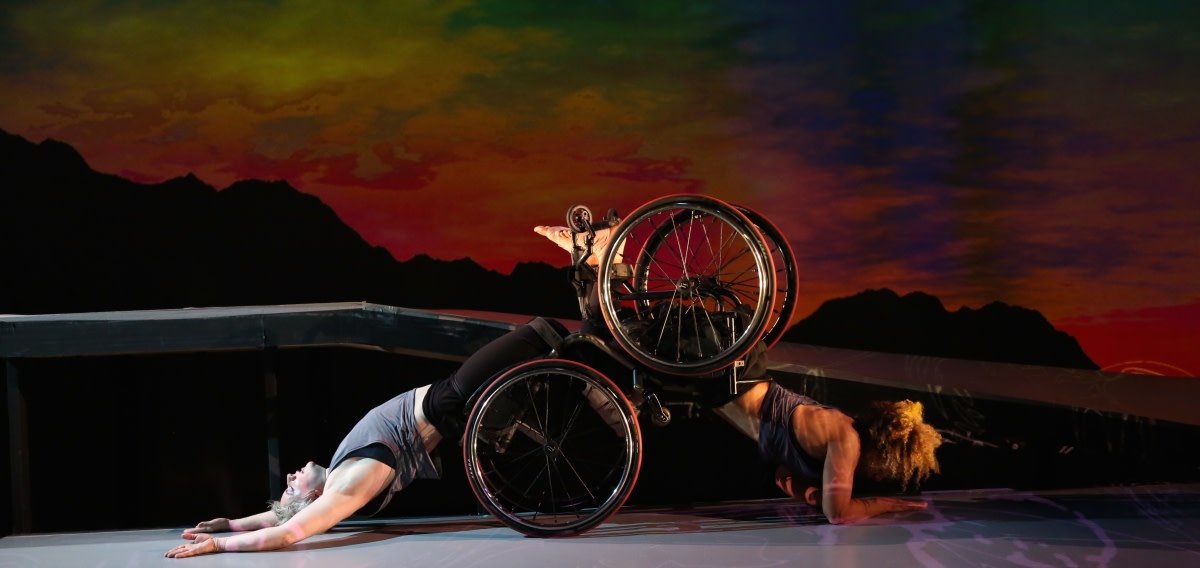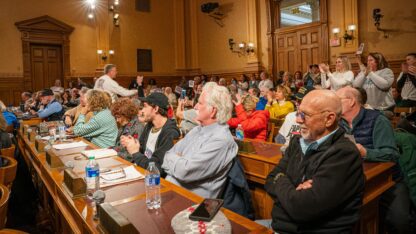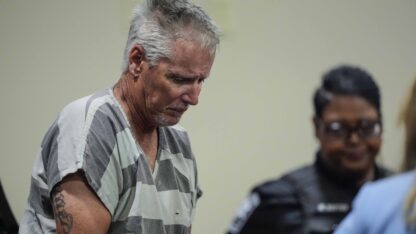Kinetic Light is an ensemble of disabled artists committed to promoting disability as a creative force.
In their new work, “DESCENT,” dancers Alice Sheppard and Laurel Lawson execute passionate and athletic choreography. Lawson joined “City Lights” to speak about creating this piece in and out of the wheelchair.
Sheppard will give a talk on Disability, Arts, and Culture on Wednesday at 5:30 p.m. The performance of “Kinetic Light: DESCENT” will take place Nov. 23 at 8 p.m. Both events will be at Georgia Tech’s Ferst Center for the Arts.
Full Transcript
Lois Reitzes’ interview with Laurel Lawson of Kinetic Light aired Nov. 14, 2019, on WABE-FM’s “City Lights” with Lois Reitzes
Lois Reitzes (LR): Kinetic Light is an ensemble of disabled artists committed to promoting disability as a creative force in their new work, “DESCENT.” Dancers Alice Sheppard and Laurel Lawson execute passionate and athletic choreography. Laurel Lawson joined me to speak about creating this piece in and out of the wheelchair.
Laurel Lawson (LL): Kinetic Light is the first professional collective of disabled artists in the country. Now, what that means basically is that there were a few of us who really, really wanted to work together who have been making work in dance and in multimedia productions for a long time. We recognized that the art we make is influenced by our identity. It doesn’t mean that we are making art about disability. We are not making art just for other disabled people, but it does mean that we have a different perspective on the world and that the art we make and the stories we tell are influenced by those aspects of our identity, just as they are influenced by any artist’s gender or race or class or upbringing.
LR: I read that your new work “DESCENT” reflects your interpretation of a sculpture of Venus and Andromeda by Rodin. Would you talk about that inspiration?
LL: My collaborator and the founding and lead artist of Kinetic Light invited me over to spend the holidays with her a few years ago, and, when I arrived, on every surface there were art books open to photographs of sculptures, to essays about Rodin, to writings by Rodin. And, Alice is an academic at heart; she had seized upon these writings of Rodin about beauty. He was so far ahead of his time in understanding that beauty did not belong solely to the white Western female form. He sculpted racialized bodies. He sculpted women of African descent at a time when that was not done. He sculpted people who were disabled. He sculpted people who were elderly, and he sculpted dancers. But this one statue, “The Twilight of Venus and Andromeda,” I mean why put those two characters together? They are not even from the same mythological system. There is no story in which they meet, so it’s a mystery. And, we decided to solve the mystery, create that story, and that is what we put on stage in “DESCENT.”
LR: How do you translate sculpture to movement?
LL: We explore a lot of different ways to bring that sculpture into choreography. There are certain positions that we use that we may pass through in movement or that served as the genesis of a phrase or a partnering position. But more than that, you also see the sculptures in the projections through which we move. There are characters represented by sculptures that appear in the story that the projections are telling, and those characters interact with the live dancers on stage. We interact with them, and we weave it all into multiple stories that we are telling in one show.
LR: What led you to dance?
LL: Dance was not something I ever planned to pursue. I went through, I suppose, the usual range of career aspirations – musician, academic. I was actually planning to be a doctor. I had planned to pursue an MD/Ph.D., gone through my undergrad with that, and I burned out pretty hard in my undergrad. I was already pursuing graduate work, working far too many hours, so I took a gap year. And, during that year, I went back to some of my roots, taking some musician gigs, studio work when I could get it, doing a little bit of acting, and just for fun I took a dance class. A month or two after that, I got an email from the man who taught the class. That man was Douglas Scott, who is the founder and artistic director of Full Radius Dance, which is Atlanta’s only physically integrated dance company and one of the premier companies working in that field in the world, and he invited me to come in and work with the company. And, well, it must of stuck. [LR laughs] Because that was 16 years ago.
LR: You were discovered! I know that you began on your professional dance career with Full Radius. Will you tell us more about the experience of working with them?
LL: In many ways, I think the world of being a working dancer is somewhat arcane. I certainly had no idea what I was getting into. I will say the first two or three years were some of the most difficult I had experienced. I was challenged in a completely new way in terms of work and study, and dance is an incredibly difficult discipline to pick up. I mean, most professional dancers train literally for decades before coming on to a professional stage, and I was given the opportunity to try and pick it up very quickly and basically as a young adult. All of that said, it was an incredibly valuable and rich experience. The philosophy of Full Radius Dance is grounded in the equality of all bodies on stage, the artistic level of the work, the technical rigor, and those are all things that really drew me in. It was the combination of art and physicality.
LR: You are not only an artist and an athlete [LL laughs], because a dancer must be artist as well as athlete. You also have engineering knowledge. I understand that you collaborated on designing the ramp that serves as your set, and you used this set without wheelchairs. What is the importance of the ramp?
LL: My participation in the ramp design was actually almost wholly as an end user. That credit goes to Sara Hendren and her students at Olin College, who built this for us. At the time, we did not realize that it would become the basis of this work. This was wholly an experiment, but the significance of the ramp is that it is an object of art in and of itself. It’s not a functional ramp; it doesn’t go anywhere. It simply is, and, in so existing that an object so commonly seen as solely existing for access… so often ramps are slapped onto buildings as afterthoughts, as necessary but unattractive additions. This is a ramp that is a thing of beauty in and of itself. We do use it without our wheelchairs. We also use it with our wheelchairs, which I designed in collaboration with Paul Schulte of Top, and they are the only two like them in the world. They are prototypes built explicitly for professional dance at this level.
LR: Wow! You also designed the app that gives and audio description of the performance. Please tell us about the sound design for “DESCENT.”
LL: For blind or visually impaired users, audio description involves a person usually sitting up in the booth who is watching the performance and then speaking, translating it into verbal language, and then that is sent to audience members. When we began doing in-process showings of “DESCENT,” members of our community came up to us [and] said, “I couldn’t understand what was going on.” There was audio description, but they could feel and hear other audience members responding to the performance, leaning forward in their seat, holding their breath, gasping. And, they were not getting that experience from the audio description, and it was really painful to us that these were, you know, our friends who we had invited to experience this, and we had failed at giving them that experience. So, in collaboration with a number of those audience members, I started playing around, and Audimance evolved from that.
LR: How long did it take you develop this app?
LL: The initial development probably took about six months. And, at the moment, we are still running it in a very rudimentary form while we are going through the next stages of development, which will be to turn it into a native mobile application. It will eventually be abstracted and available for use in such a way that other artists, other venues can use it to make their performances accessible without necessarily needing to hire an audio describer to be physically present at every performance.
LR: And, in so doing, you are expanding the audience for visually impaired or non-sighted people to enjoy dance.
LL: Disabled people like to go to shows too. It’s simply a matter of letting us in – whether making sure that there is enough seating.
LR: You want to invite and welcome everyone who can enjoy it.
LL: Precisely, and ensure that they truly have an equitable experience of the art.
LR: You and your colleague Alice Sheppard have talked about feeling the dance in your wheels. What does it mean to feel something in your wheels?
LL: Very simply, our wheelchairs are parts of our bodies. We are not sitting in furniture. This body that I exist in right now is as much Titanium and Carbon fiber as it is flesh and bone, so understanding that is really critical to understanding how you dance in this body.
LR: Well, Laurel Lawson this has been so enlightening. Congratulations, and I thank you.
LL: Thank you very much, Lois.
LR: Laurel Lawson of Kinetic Light. Laurel’s colleague Alice Sheppard will give a talk on disability, arts, and culture on Wednesday, November 20 at 5:30 p.m. The performance of Kinetic Light: “DESCENT” will take place Saturday, November 23, at 8 p.m. Both events will be held at Georgia Tech’s Ferst Center for the Arts.







